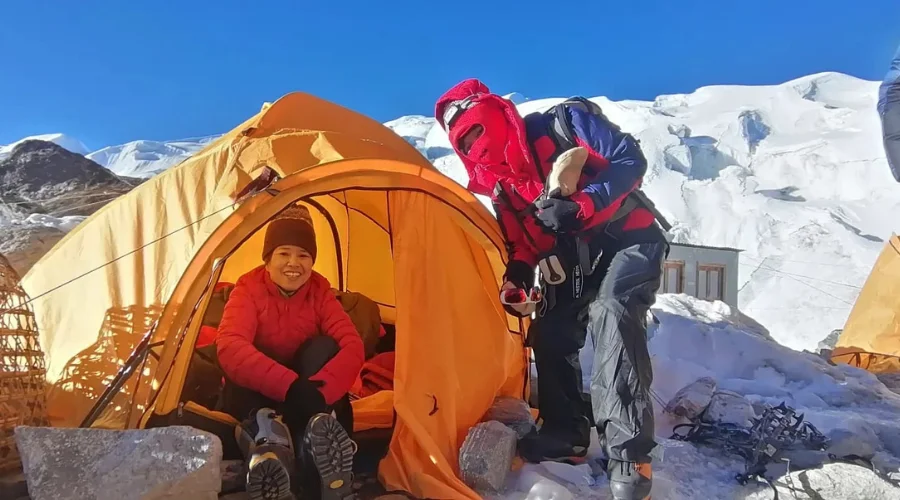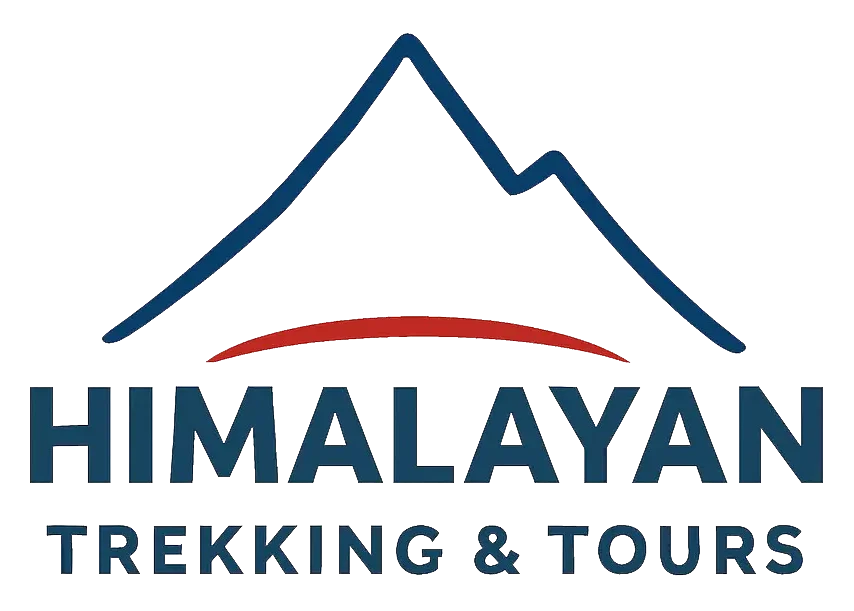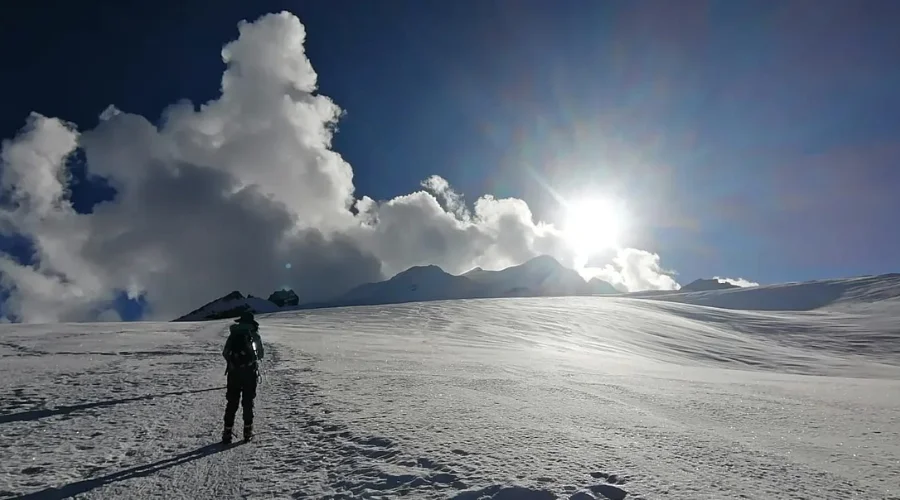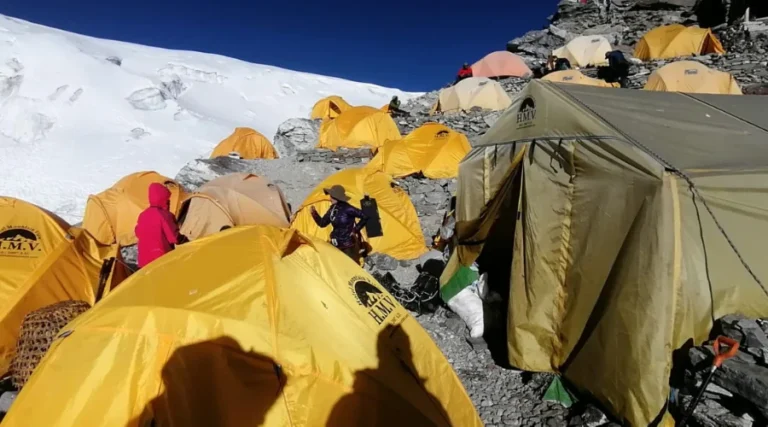Difficulty of Mera Peak Climbing
Climbing Mera Peak is challenging to medium-difficulty and accessible to hikers with essential mountaineering experience. Hiking involves long, steep slopes, and glacier walking is difficult work.
Most of it is walkable, but altitude and terrain are exhaustive regarding stamina and endurance. On glacier terrain near the summit, climbers must carry equipment (e.g., crampons and ice axes).
The hardest part is getting to the top. However, it is challenging, and climbers must ascend dangerous ice parts in unbearable weather. At altitude, the air becomes less dense and more difficult to breathe.
The climb to the summit is rather strenuous, but the stunning scenery makes the journey worthwhile and enjoyable.
Altitude Sickness at Mera Peak Nepal
Altitude is one of the most challenging aspects of the Mera Peak trek. The summit is 6,476 m high, i.e., extremely high. Altitude sickness is a possibility in ascents to climb too high before acclimatization. Symptoms include headaches, dizziness, nausea, and shortness of breath.
The itinerary incorporates rest days for acclimatization to prevent altitude sickness. It should also indicate sufficient water intake, healthy eating patterns, and control of food portions. As the illness becomes more severe, climbers should descend to lower levels to avoid death.
Food During the Mera Peak Climbing
Food along the Mera Peak trek is designed to provide the energy to do high-altitude trekking. Foodstuffs, such as dal bhat (rice and lentils), noodles, soup, potatoes and eggs, are served in the base area tea rooms.
These are freshly prepared and quite filling. Trekkers also have pancakes, bread, and porridge for breakfast. Vegetarian varieties are also easy to purchase because meat is not always high-quality in remote places.
The trekking party manages to eat as the altitude increases, e.g., even while camping. Hot soups, pasta, rice, and dehydrated items are usually on the menu to provide energy and heat.
Not surprisingly, snacks (e.g., chocolates, nuts, and energy bars) also need to be provided and may be snacked en route. Calming hot drinks, such as tea, coffee, or hot lemon, are consumed all day to give hydration and warmth.
Accommodation at Mera Peak Base Camp
As you gain altitude, the type of lodging changes on the trail, from simple tea lodges to camping. In rural settings, such as Lukla and Khare, tea houses provide simple lodging, with very few single rooms with a bed, a mattress, and blankets.

These rooms are basic but comfortable enough for rest. The toilets are communal, and hot showers require extra charges.
As trekkers ascend to higher altitudes, like Mera Peak Base Camp (5,300 meters), permanent dwellings are unavailable, and trekkers stay in tents. Camping equipment is made from the best waterproof tents, which generate heat and windhole insulation.
The trekking agency also provides high-insulation sleeping bags. The support team cooks meals in a dining tent, creating a comfortable and shared experience even in the harsh, snowy landscape.
Typical Day on the Mera Peak Climbing
Day on trekking to Mera Peak is too early and allows us to use up all the sunshine. An extensive breakfast will get underway, and a rundown of the trail to be followed that day concludes with your guide, etc.
Trekking times are likely variable, but they typically involve 5-7 hours of ground time with stops for lunch and rest. The trail offers different pitches, such as uphill, glacier traverses, and stunning sections in wild valleys.
Trekkers arrive at the end of the day’s journey to find a place to rest, eat a delicious hot meal, and acclimatize.
On summit day, the routine changes drastically. Ascending happens as early as 2-3 am to avoid becoming stuck in deteriorating conditions after reaching the summit. This is also one of the most challenging and longest days by day, the ascents of rocky, steep ice facades.
Having risen to the summit and seen the most breathtaking panorama, you retreat to camp and the duties of repose. Today is an endless dose of fun and therapy, a fulfilling and intriguing adventure.
Mera Peak Climbing Route
Sightsee flights from Kathmandu to Lukla, the gateway to the Everest area, and access the Mera Peak climbing route. From Lukla, the southernmost trail leads to Paiya, and eastward, the trail leads to Pangom.
Trekkers find wilderness, deep woodland and field villages. The path leads further and further to the breathtaking Hinku Valley, with a view of snowy mountain ranges.
Acclimatization days are usually spent in Khare (5,045 m) to acclimate climbers to hypoxia. The Khare to Mera High Camp trail is more precipitous and inclines further away from Mera High Camp (5,800 m).
The topmost approach to the summit involves walking on snow ice with crampons and ropes. In the morning, the climb starts at the summit on a very tough and uncompromising ascent to the stunning 6,476-metre summit. After the Mera Peak summit, the route retraces back to Lukla.
Mera Peak Death Rate
The mortality rate during Mera Peak is somewhat surprising compared to high mountains or technical peaks. The climb is safe for prepared and escorted trekking visitors. Nevertheless, the risks include altitude sickness, extreme weather, and icefalls on the ice near the summit.
Acclimatization, experience, and adherence to safety procedures are essential in minimizing the risk of accidents. Trekkers should know how much equipment to carry, drink enough fluids, and not hurry to the climb’s summit.
Mera Peak Success Rate
The success rate of climbing Mera Peak is not alarming; 80-90% of climbers can summit. Because climbing does not involve technical skills, the summit is one of the most accessible trekking peaks in Nepal.
A high success rate is possible due to sufficient acclimatization, organized support, and a carefully planned schedule. Spring (March-May) and autumn (September-November) are the most suitable months for climbing due to good weather and reasonable sight distance.
Mera Peak Weather
Conditions on Mera Peak differ dramatically according to season.
Climbing is at its peak in the spring (March-May) with nice weather (not too hot nor too freezing), clear sky so that it is simple to look up, and nearby blooming rhododendrons on the trail’s edge.
Autumn (September-November) is another favourable season characterized by stable temperatures and poor viewability. Daytime is spring, but at night, temperatures are cooler, particularly at the summit.
Winter (December-February) is frigid, with an average temperature below -20 degrees Celsius at high altitudes, and hence has a low attractiveness period for climbing.
Monsoon (June-August) rainstorms flood the area with torrential precipitation, creating slippery surfaces, low visibility, and, consequently, more complex and less rewarding climbing.
Mera Peak Climbing Packing List
Clothing
- Base layers (thermal tops and bottoms)
- Insulating jacket (down or synthetic)
- Waterproof and windproof jacket
- Waterproof pants
- Fleece jacket or sweater
- Hiking pants
- Warm hat and balaclava
- Sun hat or cap
- Gloves (lightweight and insulated)
- Socks (wool or synthetic, multiple pairs)
- Gaiters (for snow protection)
- Down jacket (for summit day)
Footwear
- Hiking boots (waterproof)
- Mountaineering boots (for high altitudes)
- Camp shoes or sandals
Climbing Gear
- Crampons
- Ice axe
- Climbing harness
- Helmet
- Trekking poles (with snow baskets)
Sleeping Gear
- Sleeping bag (-20°C rated)
- Sleeping pad (inflatable or foam)
- Pillow
Personal Items
- Passport and copies
- Trekking permits
- Travel insurance documents
- First-aid kit (including altitude sickness medication)
- Personal hygiene items (toothbrush, toothpaste, etc.)
- Towel (quick-dry)
- Toilet paper and wet wipes
- Sunscreen (SPF 30 or higher)
- Lip balm with SPF
- Sunglasses (UV protection)
Hydration & Food
- Water bottles (1-2 litres)
- Water purification tablets or filter
- Energy snacks (nuts, chocolate, bars)
Electronics
- Camera and memory cards
- Headlamp (with extra batteries)
- Power bank
- Phone (optional)
- Solar charger or charging cable
Miscellaneous
- Duct tape
- Trekking map
- Notebook and pen
- Ziplock bags (for trash)
- Lock for your duffel bag
- Climbing tape (for hand protection)
Permits for Mera Peak Trek
Trekking to Mera Peak requires obtaining a certain number of permits priced based on nationality and season. The Nepal Mountaineering Association (NMA) requires the Mera Peak Climbing Permit for all mountaineers.
Spring Season (March-May):
- Nepali climbers: NPR 4,000
- Foreigners: USD 250
Autumn Season (September-November):
- Nepali climbers: NPR 2,000
- Foreigners: USD 125
Winter (Dec-Feb) and Summer/Monsoon (June-August):
- Nepali climbers: NPR 1,000
- Foreigners: USD 70
Moreover, trekkers should get a Sagarmatha Entry Permit (the rate of NPR 3,000 for foreign nationals, NPR 1,500 for the citizens of SAARC countries, and NPR 100 for the citizens of Nepal).
A Local Area Permit will also be purchased for NPR 2,000 per person. Permits must be obtained through a permit trekking company or guide for stress-free trekking.
Mera Peak Climb Travel Insurance
Travel insurance is essential for climbing Mera Peak. It offers a financial safety net and emergency relief for altitude sickness, accidents, and voluntary trip abandonment.
Insurance must formally include coverage for high-altitude trekking, up to 6,500 m climbing, and helicopter rescue as the safest reaction to medical emergencies in the remote Himalayan range.
When buying insurance, please check whether medical treatment, accidents, and personal property are covered. Policies mainly cover weather or political stoppages that prevent travel.
You should have a handwritten copy of your policy and emergency contact information while on the route.
Tipping Culture
Tipping is a well-known practice and is generally welcome in Nepal’s trekking and climbing culture.
Although tipping is voluntary, it reflects appreciation for the work done by those who lead climbers, lift, secure, and help them make a climb safe and sound.
Generally, a recommendation is about 10-15% of the trip value, divided among the crew. Porters earn around USD 5-10/day, whereas those working as guides or climbing Sherpas are tipped more generously, for example, USD 10-20/ day.
Often, trekkers give tips during a brief ceremony as a thank-you gesture to the team. Please always pay in Nepalese rupees or US dollars and give us your suggestions with a smile.
Mera Peak Climbing Cost
Mera Peak climbing cost typically varies between USD 2,500 to USD 4,000 per individual. This includes fees for permits, guides and porters, meals, accommodation and transport, and the climbing gear and equipment.
The cost of climbing Mera Peak can depend on the trekking agency, the services offered, and whether you choose an ordinary or luxurious tour. Himalayan Trekking and Tours provides one of the best Mera Peak trek packages.
These include personal expenses, travel insurance, tipping the climbing crew, and other activities such as helicopter rides or extra acclimatisation days. These are excluded from our package.
Climbing Season for Mera Peak
Climbing Mera Peak is best in spring (March to May) and autumn (September to November). During these months, fine weather, overcast skies, and moderate temperatures make the climb enjoyable and safe.
In spring, the rhododendron cover is in full flower, and the trail is in good shape for walking and scrambling. Autumn season provides views of the surrounding hills and a vast amount of the scene, including Everest, Lhotse and Makalu, which offer a fantastic panorama from above.
Winter (December to February):
Winter is freezing (temperatures down to -20°C or higher) in the high-altitude regions. Poor conditions, snowfalls and frozen slopes all contribute to the difficulty of the ascent. However, it is within the reach of adequately equipped and seasoned mountaineers who tolerate exposure to severe cold.
Monsoon/Summer (June to August):
Monsoons are seeding shoring, slippery trails, and poor sight. The risk to both movement, landslide, and flooding is high, and ascending is not usually advisable. The Hinku Valley is rain-shadowed, and its exploitation may not be entirely out of reach by effective management.
Although climbing is technically possible all year round, the number of successful climbs and the amount of fun you’ll have will be much more significant during the recommended spring and autumn periods. Preparation, the use of quality equipment, and guidance by professionals are essential.
Drinking Water
Fluid intake is essential for high-altitude hydration while trekking Mera Peak. Water stations are located in villages, tea houses, along the trail or nearby.
Some water may not be drinkable; hence, it must be treated. To ensure their safety, it is proposed that water treatment tablets, filters, or UV sterilizer bottles be carried out for trekkers.
Boiled water is available at teahouses and lodgings, but it costs more the higher you go. An alternative to this is using a reusable bottle incorporating a filter.
Adequate fluid intake is a component of high‐altitude disease prevention, and climbers are consequently advised to consume a minimum of 3‐4 l/day of water as they climb.
WiFi, Electricity, and Communication
WiFi and associated communications infrastructure are poorly developed and fragile in the remote context, e.g., Mera Peak Nepal.
Access to a WiFi network is teased in certain teahouses of Mera Peak Climbing. Yet, connectivity will typically be slow and might even involve an additional fee to use. With an increase in altitude, WiFi availability diminishes.
There is a facility for electricity to top up charging devices in tea houses, but this is almost undoubtedly solar-powered and, as such, unreliable. Charges for using electricity increase with altitude, so carrying a power bank or solar charger is recommended.
Regarding communication, SIMs with data coverage (e.g., Ncell or NTC) could provide connectivity in some regions. Still, the signal weakens to low or even wholly disappears at higher elevations from (the base of the site). Satellite phones are the most potent means of communication in emergencies.














